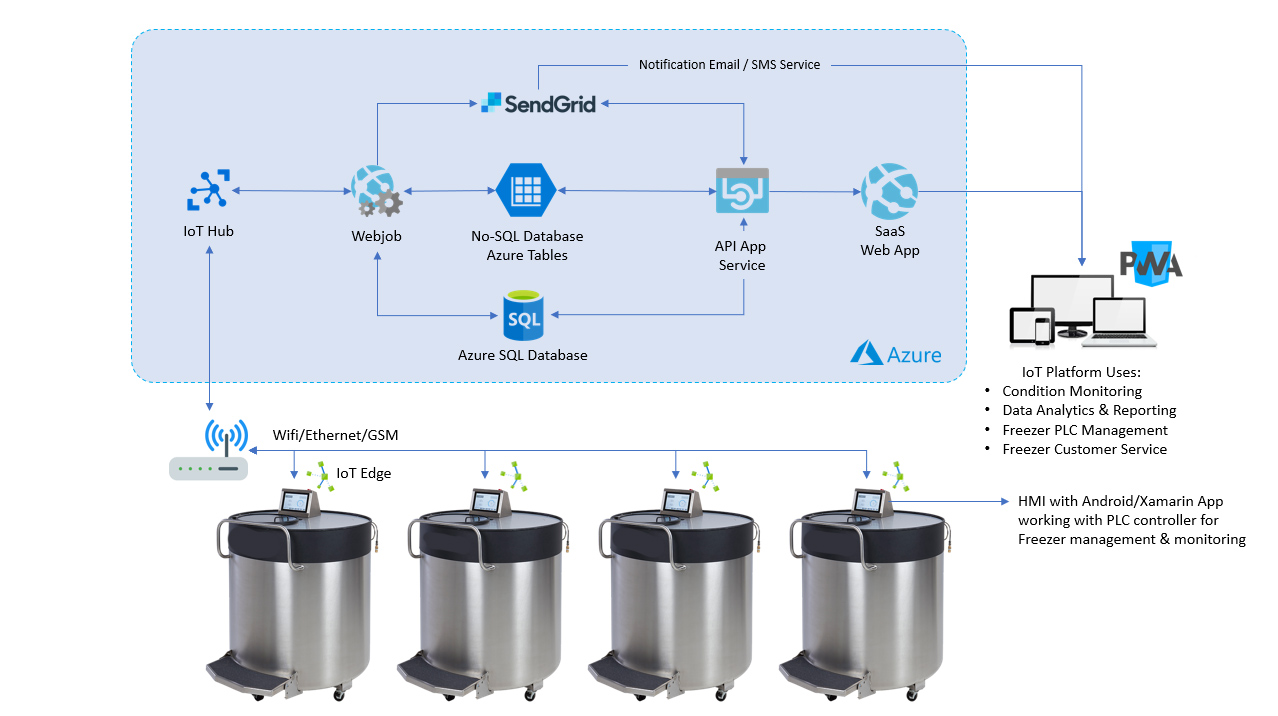Digital Transformation generally means large Enterprise with complex set of IT solutions getting reorganized & reengineered with new set of Digital technologies like Cloud, Analytics, IoT etc. But our client story is a different kind of ‘Digital Transformation’, which is happening across the globe; where greenfield development of products is thought from a perspective of being Digital First. The transformation here is happening on the drawing board itself rather than being an afterthought; which is the case with most of the large enterprises who have invested heavily in IT & Automation systems before these Digital technologies became a mainstay.
Headquartered in Missouri, our client produces high-end medical devices, which today are part of the medical supply chain fighting the Coronavirus pandemic - by safely storing Viral & Bacterial Specimen, Stem Cells, Tissues, Biofluids (Blood, Plasma, etc.). These products are digitally ready and are now Advanced, Connected and Smart; which compete directly with the products of large Billion-dollar enterprises like Thermo Fisher Scientific & GE Medical.
The Challenges
While use of a Programmable Logic Controller (PLC) based electro-mechanical automation is very common since long, what is still rare, and complex is using the PLC based systems to interact and collaborate with the IT Networks & Applications.
Today with the penetration and easy availability of Cloud connectivity and HMI (Human-Machine Interface) based platforms like Tablets & Apps, any device having PLC based automation systems working can be extended to become an IoT & Mobility based Smart Device in turn accruing the benefits these technologies bring on the table.
Our Client teams are the experts in building the Cryogenic Refrigeration enclosures controlled via PLC based systems, along with the required steel container engineering expertise. The company was looking for a long-term IoT development consulting partner on the ‘Digital’ side – who can help them both on the HMI (Mobility) Platform & on the Cloud based IoT platform; to make their Cryogenic Freezers smart & connected. The company also offers Cryopreservation storage solutions for Hospitals, Clinics, Labs, Biotech, and Pharmaceutical companies.
The Solution - Secure & Scalable Cloud based IoT Platform
With rich experience working on Cloud, IoT, and HMI-Mobility interfaces, Saviant team has architected and developed a Full Digital Platform combining Microsoft technologies like Azure IoT, Azure Data Platform, Azure Cloud-Native Services & Xamarin Cross-Platform mobility.
The Digital Platform was designed from a 5-year roadmap perspective where, the client will be onboarding their new product ranges seamlessly on the same platform while their number of customers and building of medical device products grow exponentially.
An important aspect taken care while designing the solution is the ease of management of the platform by the client team. Our IoT development team heavily invested in developing a full Cloud-Native IoT Platform which doesn’t need much configuration, administration but at the same time is highly secured and highly scalable.
Similarly, for the HMI-Mobility application part of the platform, we leveraged Xamarin Cross-Platform development framework to develop a robust App, which has a native backward integration with the Cloud-Native IoT platform and forward integration with PLC board of the Cryogenic freezers. Making the solution truly future-ready, Edge Computing functionality from Azure IoT Edge has been incorporated. This will help in Machine Learning based Advanced Analytics of the Freezer data getting pushed out from the PLC. The solution also enables seamless offline sync of freezers data in case of internet connectivity loss.
 Cloud based IoT platform architecture diagram
Cloud based IoT platform architecture diagram
The Benefits
With the addition of Digital Platform, our client’s products immediately have important added features and benefits for the actual users - who are Pharmaceutical & Biotech Companies, Hospitals, Clinics and Labs. With having two interfaces for the freezers, HMI App on the freezers and the Cloud based Web App, its customers and service teams now have Redundant Remote Monitoring & Management of these Cryogenic freezers. For our client teams, they have complete visibility into the health and condition of their product giving back great analytics. This will in turn helps R&D for the new versions and new products.
With the Multi-tenant SaaS solution based on Cloud, the overall operating costs remain very less for our client but gives them a great leverage to compete with established players and do good amount of Cross-Sell and Up-Sell in their target markets.
Most importantly our client doesn’t need a team of Cloud, Mobile, Analytics & IoT Developers and another team of IT Pros to manage this Digital Platform. This is all taken care effectively by Saviant teams remotely, while our client teams develop their next set of Medical Device products.